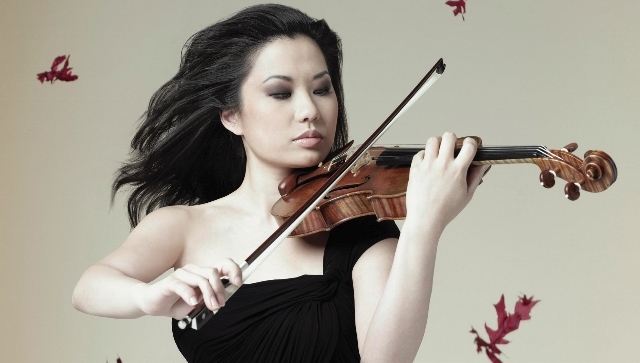A hint of dance, a dash of American soul, a splash of color and prodigious talent ushered in the Grand Rapids Symphony’s 2017-2018 season on Friday night. This season marks the first under GRS Music Director Lehninger’s full leadership, as well as the orchestra’s return to Carnegie Hall this April.
In his opening remarks, Lehninger acknowledged the tremendous amount of work it took to plan the season’s programs, before dedicating it to Roger Nelson, the GRS’s late vice president and chief operating officer who passed away suddenly last March.
Lehninger then lead the world premiere of Jeremy Crosmer’s “Ozark Traveler.” New to the Detroit Symphony Orchestra’s cello section this season, Crosmer performed with the GRS for five years as assistant principal cellist. During that time, he composed several works for the GRS, including meditative music for the Music for Health program.
Commissioned by the GRS, the piece celebrates the music of 20th century American composers such as Aaron Copland, Leonard Bernstein and Charles Ives. The piece began with strings and percussion establishing an ominous mood, then the orchestra hit its stride amid changing meters and graceful folk melodies. The music conjured imagery of lush valleys, rolling hills, and even a symphonic version of a thunderstorm reverberating off the Ozark mountain tops.
Next, the marquee attraction of the evening — violin virtuoso Sarah Chang — took the stage in a glittering black and pink gown. Chang has appeared in major concert halls and prestigious music festivals since the age of nine (she is now 36), and has claimed a number of coveted accolades, including the 1999 Avery Fisher Prize. On Friday evening, she made her second Grand Rapids appearance to perform the “West Side Story” suite for violin and orchestra. The piece was arranged especially for her by film composer David Newman from Leonard Bernstein's beloved Broadway musical.
The arrangement itself didn’t offer a creative re-envisioning of Bernstein’s musical score. Newman clearly wrote the piece to feature Chang’s multifaceted tone and spellbinding technique, giving the violin most of the melodies (which she adorned with jaw-dropping flourishes). The overwhelming orchestration of the fast-paced passages swallowed Chang’s sound at times, despite the performers’ and Lehninger’s best efforts. Nevertheless, Chang’s performance was memorable in that it was heartfelt, yet unsentimental, as she passionately expressed lyrical phrases and moved with athletic intensity during the “Mambo” coda.
Sergei Rachmaninoff’s final composition (and the only one he completed after immigrating to the United States) opened the concert’s second half. “Symphonic Dances” provides compelling musical evidence that the Russian composer knew it would be his swan song. It is heavy with transfigured melodies of his earlier work, spiritual features like bells and liturgical chants, and otherworldly scoring of instruments. Notably, “Symphonic Dances” gives prominence to the Dies irae motif — better known as the Wilhelm Scream of classical music. Rachmaninoff often used this “death theme” born from a medieval hymn in many of his works, but it appears in “Symphonic Dances” an unprecedented amount.
It was a joy to hear the GRS orchestra present the three-movement piece, which is at turns wistful, gloomy and diabolical. Lehninger’s interpretation embraced the rhapsodic sentimentality for which Rachmaninoff is revered, but was also jazzy, muscular and blunt when needed. A spectral alto saxophone solo by Joseph Lulloff during the first movement helped establish the macabre mood.
An orchestral crowdpleaser and the concert’s namesake concluded the evening. The crux of Maurice Ravel’s “Bolero” is a looped 16-bar melody passed between instruments over the course of a quarter hour. Under the steady guidance of Bill Vits on snare drum, the orchestra balanced the piece’s mechanical nature with its quirky orchestral surprises and colors along the way. Save for a few stray notes (the piece is unforgiving in that regard), each soloist demonstrated individual flair as the accompaniment swelled to the frenetic finale.
Between the suspenseful buildup and the shifting colors of each iteration of sinuous melody, “Bolero” evoked a transition of seasons, in all senses of the word: the shift to a new era of leadership and the commencement of another year of superb musical moments, all with West Michigan fall foliage as the backdrop.
Bolero
Sept. 15 & 16, 8 p.m.
DeVos Performance Hall
303 Monroe Ave. NW, Grand Rapids
$18 and up, grsymphony.org, (616) 454-9451 x 4





